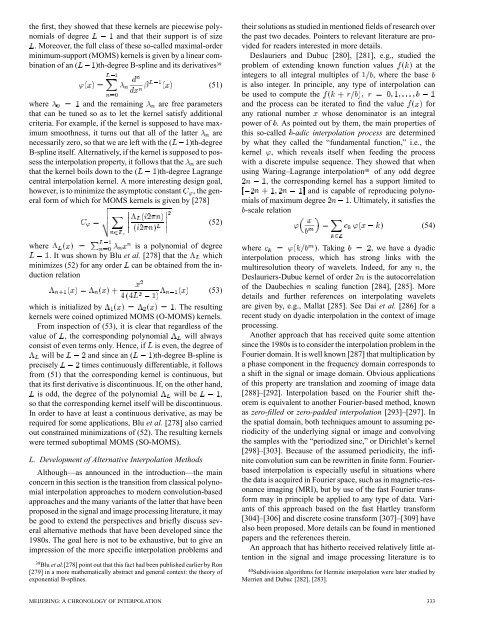from ancient astronomy to modern signal and image processing
from ancient astronomy to modern signal and image processing
from ancient astronomy to modern signal and image processing
Create successful ePaper yourself
Turn your PDF publications into a flip-book with our unique Google optimized e-Paper software.
the first, they showed that these kernels are piecewise polynomialsof degree <strong>and</strong> that their support is of size. Moreover, the full class of these so-called maximal-orderminimum-support (MOMS) kernels is given by a linear combinationof an ( )th-degree B-spline <strong>and</strong> its derivatives 39(51)where <strong>and</strong> the remaining are free parametersthat can be tuned so as <strong>to</strong> let the kernel satisfy additionalcriteria. For example, if the kernel is supposed <strong>to</strong> have maximumsmoothness, it turns out that all of the latter arenecessarily zero, so that we are left with the ( )th-degreeB-spline itself. Alternatively, if the kernel is supposed <strong>to</strong> possessthe interpolation property, it follows that the are suchthat the kernel boils down <strong>to</strong> the ( )th-degree Lagrangecentral interpolation kernel. A more interesting design goal,however, is <strong>to</strong> minimize the asymp<strong>to</strong>tic constant , the generalform of which for MOMS kernels is given by [278](52)whereis a polynomial of degree. It was shown by Blu et al. [278] that the whichminimizes (52) for any order can be obtained <strong>from</strong> the inductionrelation(53)which is initialized by. The resultingkernels were coined optimized MOMS (O-MOMS) kernels.From inspection of (53), it is clear that regardless of thevalue of , the corresponding polynomial will alwaysconsist of even terms only. Hence, if is even, the degree ofwill be <strong>and</strong> since an ( )th-degree B-spline isprecisely times continuously differentiable, it follows<strong>from</strong> (51) that the corresponding kernel is continuous, butthat its first derivative is discontinuous. If, on the other h<strong>and</strong>,is odd, the degree of the polynomial will be ,so that the corresponding kernel itself will be discontinuous.In order <strong>to</strong> have at least a continuous derivative, as may berequired for some applications, Blu et al. [278] also carriedout constrained minimizations of (52). The resulting kernelswere termed suboptimal MOMS (SO-MOMS).L. Development of Alternative Interpolation MethodsAlthough—as announced in the introduction—the mainconcern in this section is the transition <strong>from</strong> classical polynomialinterpolation approaches <strong>to</strong> <strong>modern</strong> convolution-basedapproaches <strong>and</strong> the many variants of the latter that have beenproposed in the <strong>signal</strong> <strong>and</strong> <strong>image</strong> <strong>processing</strong> literature, it maybe good <strong>to</strong> extend the perspectives <strong>and</strong> briefly discuss severalalternative methods that have been developed since the1980s. The goal here is not <strong>to</strong> be exhaustive, but <strong>to</strong> give animpression of the more specific interpolation problems <strong>and</strong>39 Blu et al.[278] point out that this fact had been published earlier by Ron[279] in a more mathematically abstract <strong>and</strong> general context: the theory ofexponential B-splines.their solutions as studied in mentioned fields of research overthe past two decades. Pointers <strong>to</strong> relevant literature are providedfor readers interested in more details.Deslauriers <strong>and</strong> Dubuc [280], [281], e.g., studied theproblem of extending known function values at theintegers <strong>to</strong> all integral multiples of , where the baseis also integer. In principle, any type of interpolation canbe used <strong>to</strong> compute the<strong>and</strong> the process can be iterated <strong>to</strong> find the value forany rational number whose denomina<strong>to</strong>r is an integralpower of . As pointed out by them, the main properties ofthis so-called -adic interpolation process are determinedby what they called the “fundamental function,” i.e., thekernel , which reveals itself when feeding the processwith a discrete impulse sequence. They showed that whenusing Waring–Lagrange interpolation 40 of any odd degree, the corresponding kernel has a support limited <strong>to</strong><strong>and</strong> is capable of reproducing polynomialsof maximum degree . Ultimately, it satisfies the-scale relation(54)where . Taking , we have a dyadicinterpolation process, which has strong links with themultiresolution theory of wavelets. Indeed, for any , theDeslauriers-Dubuc kernel of order 2 is the au<strong>to</strong>correlationof the Daubechies scaling function [284], [285]. Moredetails <strong>and</strong> further references on interpolating waveletsare given by, e.g., Mallat [285]. See Dai et al. [286] for arecent study on dyadic interpolation in the context of <strong>image</strong><strong>processing</strong>.Another approach that has received quite some attentionsince the 1980s is <strong>to</strong> consider the interpolation problem in theFourier domain. It is well known [287] that multiplication bya phase component in the frequency domain corresponds <strong>to</strong>a shift in the <strong>signal</strong> or <strong>image</strong> domain. Obvious applicationsof this property are translation <strong>and</strong> zooming of <strong>image</strong> data[288]–[292]. Interpolation based on the Fourier shift theoremis equivalent <strong>to</strong> another Fourier-based method, knownas zero-filled or zero-padded interpolation [293]–[297]. Inthe spatial domain, both techniques amount <strong>to</strong> assuming periodicityof the underlying <strong>signal</strong> or <strong>image</strong> <strong>and</strong> convolvingthe samples with the “periodized sinc,” or Dirichlet’s kernel[298]–[303]. Because of the assumed periodicity, the infiniteconvolution sum can be rewritten in finite form. Fourierbasedinterpolation is especially useful in situations wherethe data is acquired in Fourier space, such as in magnetic-resonanceimaging (MRI), but by use of the fast Fourier transformmay in principle be applied <strong>to</strong> any type of data. Variantsof this approach based on the fast Hartley transform[304]–[306] <strong>and</strong> discrete cosine transform [307]–[309] havealso been proposed. More details can be found in mentionedpapers <strong>and</strong> the references therein.An approach that has hither<strong>to</strong> received relatively little attentionin the <strong>signal</strong> <strong>and</strong> <strong>image</strong> <strong>processing</strong> literature is <strong>to</strong>40 Subdivision algorithms for Hermite interpolation were later studied byMerrien <strong>and</strong> Dubuc [282], [283].MEIJERING: A CHRONOLOGY OF INTERPOLATION 333
















